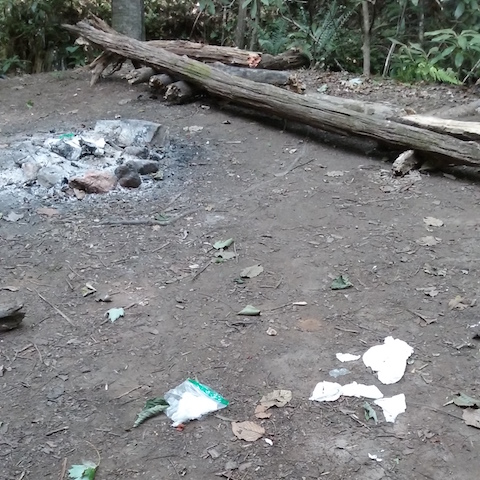AT Lesson #11: Don’t Feed the Stereotypes


The backpackers I know strictly adhere to the pack-it-in-pack-it-out philosophy. Unfortunately, not everyone does.
I scaled the four-foot dirt bank and followed the trail as it turned sharply left and paralleled the meandering stream that I had just crossed. It was almost noon and I was hungry. I considered every small clearing as a potential spot for lunch, hoping to find a site near the water. The sound of water trickling over rocks creates a nice ambiance while eating, but I had a more compelling and practical reason to eat near water. I could drink deeply from my water bottles and fill up again before hitting the trail.
As I walked, searching for a place to stop, something caught my eye, something I hadn’t seen on this trip until now.
In small clearing beside the stream, logs had been arranged in the shape of a U. In the center, a small fire ring made of softball-sized rocks held ashes. It also contained several blackened soda cans, a partially melted disposable water bottle, and some unburned trash on top. Scattered around the campsite was other debris that looked to be remnants of diapers.
Taken aback I stopped and surveyed the site. Until now the trail had been nearly pristine, which is pretty remarkable given the number of hikers on the Appalachian Trail. Every backpacker I had met was meticulous about leaving a campsite better than he found it. Trash was not left for someone else to clean up. We all diligently followed the “Pack It In, Pack It Out” philosophy.
Like most other hikers, I carried a 1-gallon ziplock bag where I kept what little trash I produced until I could dispose of it properly. A few road crossings had bear-proof garbage canisters for hikers to use, otherwise we carried it until we came to a store or town.
But here, at least one camper had completely ignored the code of the trail. I shook my head in disbelief. I took off my pack and picked up some of the trash, adding it to my ziplock bag. It hardly made a difference, but I thought that every little bit helps.
Within a half mile, I came to a road crossing and understood what had happened. It wasn’t backpackers that had left this mess. It was probably locals who had hiked a short distance into the woods for a fun time camping. When the party was over, they didn’t feel like toting their discards back to their car. So, they left it.
AT Lesson #11: Don’t Feed the Stereotypes
Campers and backpackers are often seen as trespassers into the natural environment, interlopers into a world that does not belong to them. Carelessly leaving trash in their wake, they damage the unmarred habitat of nature’s fauna and flora. The stereotype of the self-centered, careless, and egotistical camper that cares nothing for the environment is reinforced with every piece of trash found.
I believe that spending time in the woods, communing with nature, actually encourages people to be better stewards of creation. In the woods you get a better appreciation of the glory of nature, and you want to protect it. As an avid backpacker, I’m aware of the damaging stereotype and do what I can to combat it. I don’t want the inconsiderate actions of a few to dictate how the world thinks of campers.
In our daily walk at work, we must be aware of stereotypes as well. IT departments are notorious for needlessly and flippantly saying no, being unresponsive and uncooperative to the needs of the business, and rudely belittling those who don’t understand the acronyms or the technology. That’s unfortunate. And it’s how “Shadow IT” becomes prevalent.
Stereotypes also invade our personal and volunteer lives. As a Christian and as a member of a local church, I know that some people automatically ascribe bigotry and intolerance to me. I know that as an adult leader in a youth development organization, some assumptions are inevitably made about me.
So what can we do?
First, be aware of the stereotype. Know that it exists and be sensitive to it. Understand that you may have a hard time convincing that business user that you’re not there to automatically quash their request but to further understand their needs and how you may be able to help.
Second, don’t feed the stereotype. As an IT professional don’t use a bunch of jargon that you think makes you sound smart. It doesn’t. Remember the quote that is often attributed to Albert Einstein, “If you can’t explain it simply, you don’t understand it well enough.”
Third, follow Stephen Covey’s advice, seek first to understand and then to be understood. Actually while you’re at it, follow all of the Seven Habits of Highly Effective People. It’s good.
I know it’s an uphill struggle, but just as getting into the woods gives you a better appreciation of nature, getting into the business gives you a better understanding of how your job affects others in the business and your customers.
“But I’m just one person and I cannot change the whole organization.” That may be true. But we can do our part and we can be an example to others. I couldn’t pick up all of the trash someone else left behind, but I carried out what I could, and I like to think that helped.
